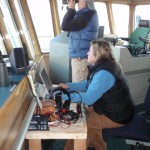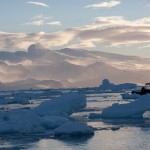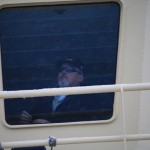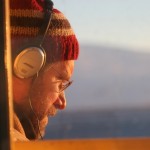Tomorrow is my mom’s birthday – Happy Birthday Mom! Last year we named one of our tagged whales after her, “Ellie,” on her birthday. How do I beat that birthday gift?
This year on her birthday we will be following a mom and juvenile pair of humpbacks — our first-ever double-tag deployment! We had a phenomenal day today. Great weather in one of our favorite bays, Wilhelmina, allowed us to conduct comprehensive visual surveys from the mouth of the bay all the way into the toe, as well as launch three small boats for whale tagging and prey mapping. We recorded over 120 humpback sightings (with commonly two or more animals in a group, so over 200 humpbacks!) during our line transect survey and over 500 sightings of all krill predators (pinnipeds, seabirds and whales) during our 300-meter strip transect survey. That is a lot of animals, including an unusual sighting of a Southern Right whale. This bay is full of life! The visual survey team had to stop and pinch ourselves a few times to remind ourselves that we were surveying in one of the densest humpback whale feeding grounds known on the planet. Wow.
- Andy identifies krill predators within 300 meters of the ship while Danielle diligently records all of his creature sightings.
The excellent weather also permitted Joe Warren to calibrate the echosounders on the ‘prey mapping’ zodiac in order to precisely estimate krill presence around a tagged whale at a fine-scale using acoustics.
- The fine-scale prey mapping zodiac takes full advantage of the beautiful weather to calibrate the echosounders.
Its busy days like today, when so many operations are happening at once, that we are reminded that our research could not be accomplished without the hard work of the RVIB Palmer crew, including the fabulous and fun marine technicians (MTs), led by our beloved Captain Joe — they make it happen. Thanks!
- From top to bottom: Chief Scientist Doug Nowacek, MT Dan Powers, Dr. Alison Stimpert, MT Julie Jackson, and MT Kelly Watson wait to board the small boats.
As I’ve alluded to, we often see humpbacks hanging out in pairs, tucked in the protected and krill-filled bays down here on the western peninsula. Some are mom-calf pairs, but not always. We want to learn more about why they hang in twos (or threes or more; or not), specifically how they are feeding on the massive amounts of krill here and how they interact with other whales within and outside of their clique. For our first go, we targeted a larger animal (presumed mom) and juvenile animal duo. We haven’t done this double-tagging thing before and although we are confident in our tracking skills, we thought it best to start ‘easy’ and tag two whales we are fairly sure will stick together. A mom and offspring are a sure bet (right mom).
- Our fearless Captain Joe keeps a watchful eye on the small boats from the bridge.
Tonight while most of us sleep, the whales will likely move around the bay to feed when the krill patches diurnally migrate to the surface, but hopefully they’ll travel synchronously. If they do, Andrew Westgate (our infamous whale tracker) will have a pleasant night; if not… we’ll keep you posted.
- Andrew Westgate enjoys a few hours of warm rays while attentively radio tracking a Dtagged humpback whale.
We tagged the adult (‘mom’) with a 48-hour tag and the smaller animal with a 24-hour tag. Tomorrow morning we’ll find our well-fed whales and keep an eye on them all day, including mapping their food at a fine- and meso-scale, documenting their behaviors with notes, photographs and vocalization recordings, and systematically counting their krill-predator compadres. They usually sleep most of the day, worn out from feeding all night. Our goal is to pick up the 24-hour tag when it falls off the juvenile, and to replace it with a “crittercam.” This will allow us to continue to record data during the 48-hour time period and integrate a ground-truthing visual perspective. (This is very exciting, never-before done in the Antarctic!)
Naturally, our two whales needed names. They have to be catchy, and they have to go together, like peas and carrots. The winners today were “Tarzan” and “Jane” — you can’t think of one without the other. If all goes well, this will not be the last pair of whales we tag during our research cruise. So this evening a few of my shipmates and I pondered, what good things come in pairs? Here’s our list. I invite you to share a ‘pair’ of your own. If we like it, we may just name the next lucky pair of tagged whales after your clever suggestion.
Good night from Wilhelmina Bay!
- We say goodnight to the adult humpback (‘mom’), fashioned with her bling bling (aka Dtag), as the sun sets and the moon rises. This scenes represents just one of the many reasons why we love Wilhelmina Bay!
– Lindsey
Good things come in pairs
Warm socks
Buy one get one free
Dice
Two guitars in Rock Band
Twins
Peanut and jelly
Strawberries and champagne
Pizza and beer
Batman and Robin
Wayne and Garth
Hot coca and marshmallows
Bella and Sophie (my beautiful nieces J)
Milk and cookies
Bunk beds
Skis







Twinkies!
The whales must be twinkies! Or a couple! That is so neat!
Tons of Whales!
Wow I did not know you could see so many whales at one time. Im ready to see the results from your tags.
Thanks
I just wanted to say thank-you for keeping a blog about your whale tagging experiences. This is my first time to read one and I learned a lot. I’m in an aquascience class at my school and our teacher told us about this site and said that we could get extra credit by writing a summary on one of the blogs. Anyway I just wanted to say thank-you I really enjoyed reading your blog and learning about how tagging the whales can teach us humans so much. It was very interesting…. keep doing what you’re doing.
Thanks again,
Melissa J.
More pairs
Laverne and Shirley; Thelma and Louise; Mutt and Jeff; Jekyll and Hyde.
I think Lindsey is going to win the “comment competition” with this post!
Antarctica
We’ve been learning about tagging in our aquascience class and it’s awesome to see how y’all are using them. Keep up the good work!
Good Things Come in Pairs
. . . And then there would be our wonderful niece and fantastic nephew, Kayla and Parker, who arrived on the Earth as a pair and who are following their cousin’s adventure via this great blog!
Check out these guns!
Biceps come in pairs, along with ears and eyes. No spare tongues or noses, unless you’re a humpback that is. They, along with other baleen whales, have two blowholes. Gotta love Nature’s bounty!
Fun
This sounds like so much fun.
Whales
Nice work!!!!
You guys are doing some amazing work and keep it up!!
I was just wondering how long exactly do whales live?
It’s a Great Day to Be Lindsey’s Mom!
Thanks for the wonderful birthday gifts via your blog and your phone wishes, Linds. I have to pinch myself daily to believe that I am the lucky mom of such an accomplished, sensitive, loving daughter. Yes, Linds, “A mom and her offspring ARE a sure bet.” And, I have one more unbeatable pair–Linds and Carita! 🙂 Hugs. I love you, “MOM”
Hurray!
Dang! It sounds like ya’ll are making some serious progress. Tell your mom i said happy birthday haha.
Good Things Come in Pairs
Meagan Mna and Caitlin Skye (my pair of daughters at Duke)
Pair Names
it’s great what y’all are doing there. i think i have great names for the next whales. Starsky and Hutch.